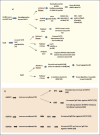Impact of Heat Shock Proteins in Neurodegeneration: Possible Therapeutical Targets
- PMID: 35875428
- PMCID: PMC9305912
- DOI: 10.1177/09727531211070528
Impact of Heat Shock Proteins in Neurodegeneration: Possible Therapeutical Targets
Abstract
Background: Human neurodegenerative diseases occur as a result of various factors. Regardless of the variety in the etiology of development, many of these diseases are characterized by the accumulation of pathological, misfolded proteins; hence, such diseases are considered as proteinopathies. While plenty of research study has been conducted in order to identify the pathophysiology of these proteinopathies, there is still a lack of understanding in terms of potential therapeutic targets.
Summary: Molecular chaperones present the main workforce for cellular protection and stress response. Therefore, considering these functions, molecular chaperones present a promising target for research within the field of conformational diseases that arise from proteinopathies. Since the association between neurodegenerative disorders and their long-term consequences is well documented, the need for the development of new therapeutic strategies becomes even more critical.
Key message: In this review, we summarized the molecular function of heat shock proteins and recent progress on their role, involvement, and other mechanisms related to neurodegeneration caused by different etiological factors. Based on the relevant scientific data, we will highlight the functional classification of heat shock proteins, regulation, and their therapeutic potential for neurodegenerative disorders.
Keywords: Alzheimer disease; Guillain–Barré syndrome; HSP27; HSP70; HSP90; Heat shock protein; Neurodegeneration; Parkinson disease.
© 2022 Indian Academy of Neurosciences (IAN).
Conflict of interest statement
Declaration of Conflicting Interests: The authors declared no potential conflicts of interest with respect to the research, authorship, and/or publication of this article.
Figures
Similar articles
-
Neurodegeneration and the Heat Shock Protein 70 Machinery: Implications for Therapeutic Development.Curr Top Med Chem. 2016;16(25):2741-52. doi: 10.2174/1568026616666160413140741. Curr Top Med Chem. 2016. PMID: 27072702 Review.
-
Folding or holding?-Hsp70 and Hsp90 chaperoning of misfolded proteins in neurodegenerative disease.J Biol Chem. 2022 May;298(5):101905. doi: 10.1016/j.jbc.2022.101905. Epub 2022 Apr 6. J Biol Chem. 2022. PMID: 35398094 Free PMC article. Review.
-
Translational Shift of HSP90 as a Novel Therapeutic Target from Cancer to Neurodegenerative Disorders: An Emerging Trend in the Cure of Alzheimer's and Parkinson's Diseases.Curr Drug Metab. 2017;18(9):868-876. doi: 10.2174/1389200218666170728115606. Curr Drug Metab. 2017. PMID: 28758577 Review.
-
Heat shock transcription factor 1-activating compounds suppress polyglutamine-induced neurodegeneration through induction of multiple molecular chaperones.J Biol Chem. 2008 Sep 19;283(38):26188-97. doi: 10.1074/jbc.M710521200. Epub 2008 Jul 16. J Biol Chem. 2008. PMID: 18632670 Free PMC article.
-
Heat shock proteins at the crossroads between cancer and Alzheimer's disease.Biomed Res Int. 2014;2014:239164. doi: 10.1155/2014/239164. Epub 2014 Jul 24. Biomed Res Int. 2014. PMID: 25147790 Free PMC article. Review.
Cited by
-
Small molecule heat shock protein 27 inhibitor J2 decreases ovarian cancer cell proliferation via induction of apoptotic pathways.Med Oncol. 2023 Jul 26;40(9):250. doi: 10.1007/s12032-023-02126-2. Med Oncol. 2023. PMID: 37493998
-
Senataxin deficiency disrupts proteostasis through nucleolar ncRNA-driven protein aggregation.J Cell Biol. 2024 Jul 1;223(7):e202309036. doi: 10.1083/jcb.202309036. Epub 2024 May 8. J Cell Biol. 2024. PMID: 38717338 Free PMC article.
-
Profiling the Hsp70 Chaperone Network in Heat-Induced Proteotoxic Stress Models of Human Neurons.Biology (Basel). 2023 Mar 9;12(3):416. doi: 10.3390/biology12030416. Biology (Basel). 2023. PMID: 36979108 Free PMC article.
-
Lateral hypothalamic area high-frequency deep brain stimulation rescues memory decline in aged rat: behavioral, molecular, and electrophysiological study.Pflugers Arch. 2025 Mar;477(3):371-391. doi: 10.1007/s00424-024-03059-z. Epub 2025 Jan 21. Pflugers Arch. 2025. PMID: 39836224 Free PMC article.
-
Protein arginine methyltransferases as regulators of cellular stress.Exp Neurol. 2025 Feb;384:115060. doi: 10.1016/j.expneurol.2024.115060. Epub 2024 Nov 17. Exp Neurol. 2025. PMID: 39551462 Free PMC article. Review.
References
Publication types
LinkOut - more resources
Full Text Sources
Research Materials
Miscellaneous



